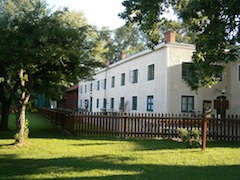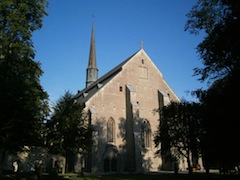|
|
|
|
 |
|
Vadstena Pilgrim Centre
 |
 |
 |
The PIlgrim Centre at Vadstena receives some 300,000 visitors a year. |
This page has not been updated since June 2014.
Christian (Protestant) pilgrim site
The Vadstena Abbey Church is the shrine of the 14th century St Birgitta who, as Birgitta Birgersdotter had a vision from Christ on which the Abbey was based.
 |
 |
 |
The Vadstena church holds four services for pilgrims every day. |
It has been an important pilgrimage site since mediaeval times, both as a destination in itself and also as a sacred place on the route to Trondheim, and remains a sacred destination for both Lutherans and Catholics. Some 300,000 people visit the pilgrim centre every year and the Church holds four services every day.
One major environmental concern is the health of the nearby lake Vättern which is the water source for many towns in the area and this will be addressed in any future greening plans to be developed.
Progress so far
The partnership between Vadstena Pilgrim Centre, the Diocese of Linkoping and the City of Vadstena municipal authority coined the Green Pilgrimage Network at an extraordinary meeting of the network in Trondheim, Norway on July 26, 2013. They are working together to produce a joint action plan for greening the pilgrimage and city. In February 2014 Vadstena hosted an inaugural meeting for a European Chapter of the GPN.
'Pearls of Life'
The Linkoping Diocese has chosen eco-theology as its theme this year and as part of their action they have adapted the “pearls of life bracelet” devised in 1995 by Swedish Bishop, Martin Lönnebo when he was stuck on a Greek island because of a storm. He had the idea of a bracelet as a contemporary aid to prayer.
Each of the colored beads, or “pearls” is a prompt for reflection. Up until now there have been 18 beads starting with a gold one for God. Then going counter clockwise, I (or Self), Baptism, Desert, Serenity, Carefree, Love (two red beads), Mystery (three white beads), Night, Silence and Resurrection. But now, a green pearl has been added.
Ewa Lundh, manager of the Pilgrim Centre, explains: “Pilgrims are asked to add a green pearl and remember that what they do to care for the environment and for each other all reflects on the wonder of creation.” The bracelets are for sale in the Church and in the Pilgrim Centre.
Useful links
Vadstena Pilgrim Centre website
Pearls of Life book published by Iona books
|
 |
|
|
|
|
|
 |
Green pilgrimage network members
The vision is of pilgrims on all continents and the pilgrim cities that receive them, leaving a positive footprint on the Earth |
 |
GPN Handbooks & Leaflets
Downloadable leaflets and handbooks for greening pilgrimage aimed at different faith groups |
 |
The Christian Declaration on Nature - Assisi 1986
The original Christian Declaration on Nature was created in 1986, at a meeting held in Assisi by WWF-International. It stemmed from an idea by HRH the Prince Philip, at which five leaders of the five major world religions – Buddhism, Christianity, Hinduism, Islam and Judaism – were invited to come and discuss how their faiths could help save the natural world. |
 |
 |
|
|

